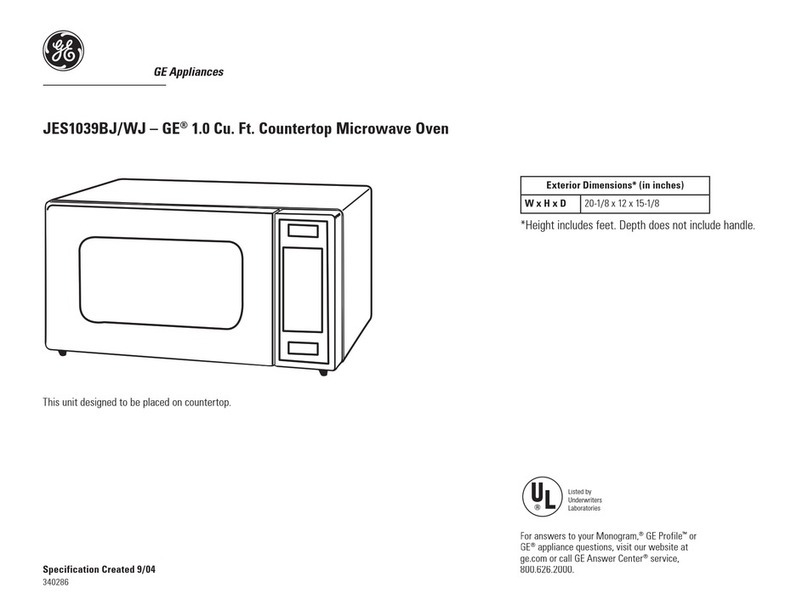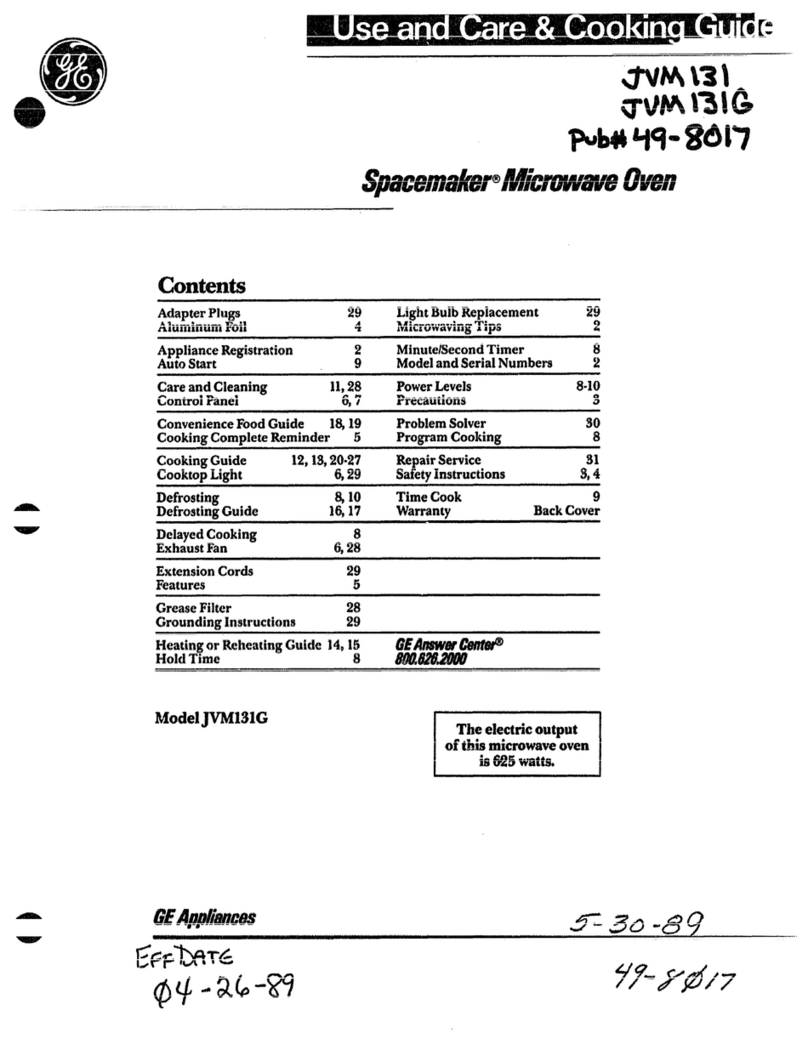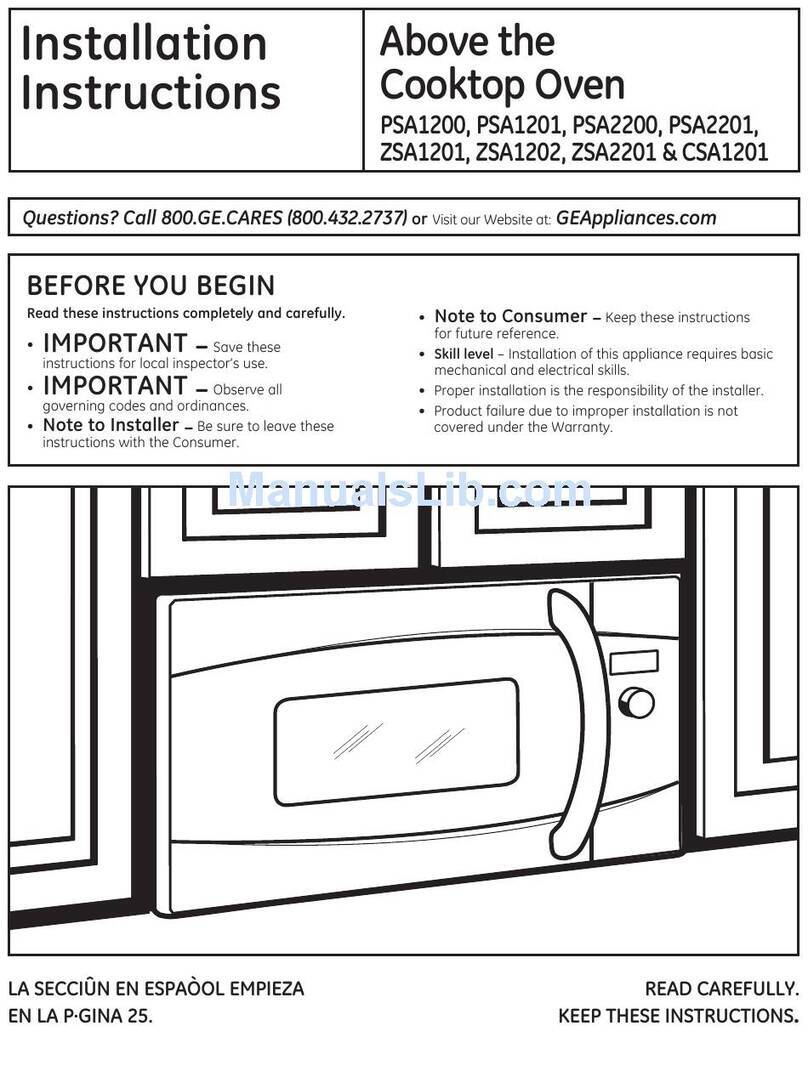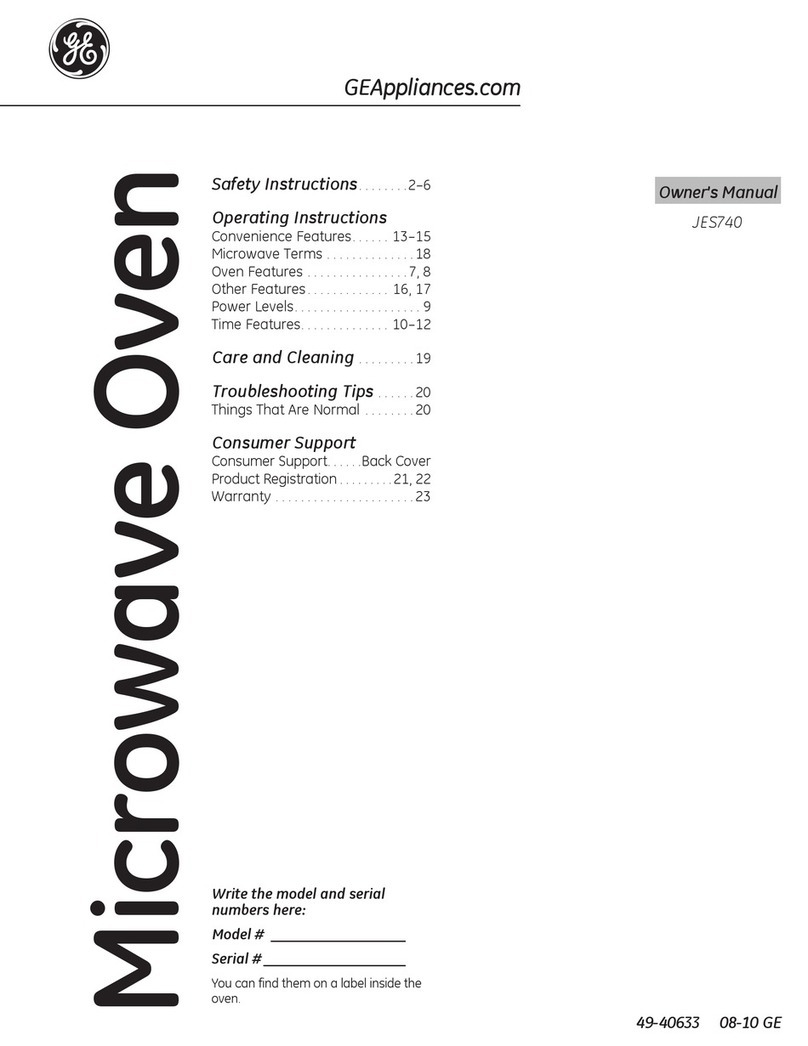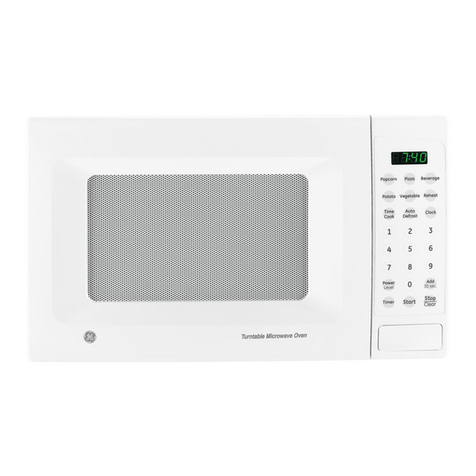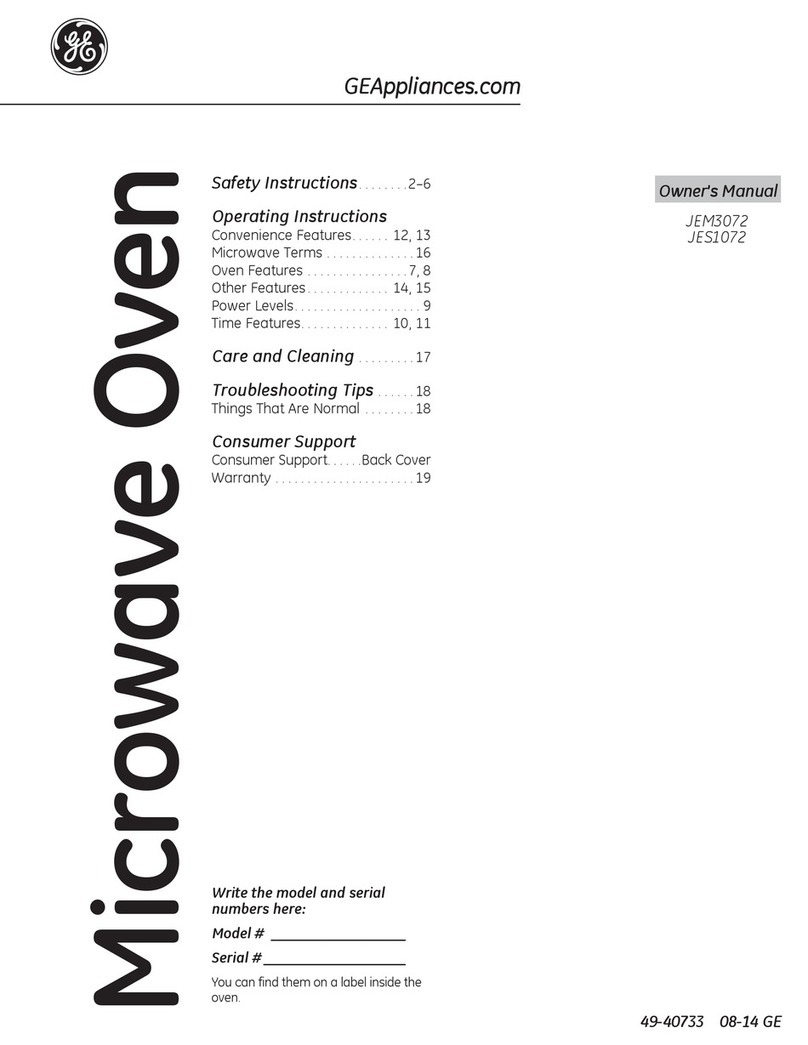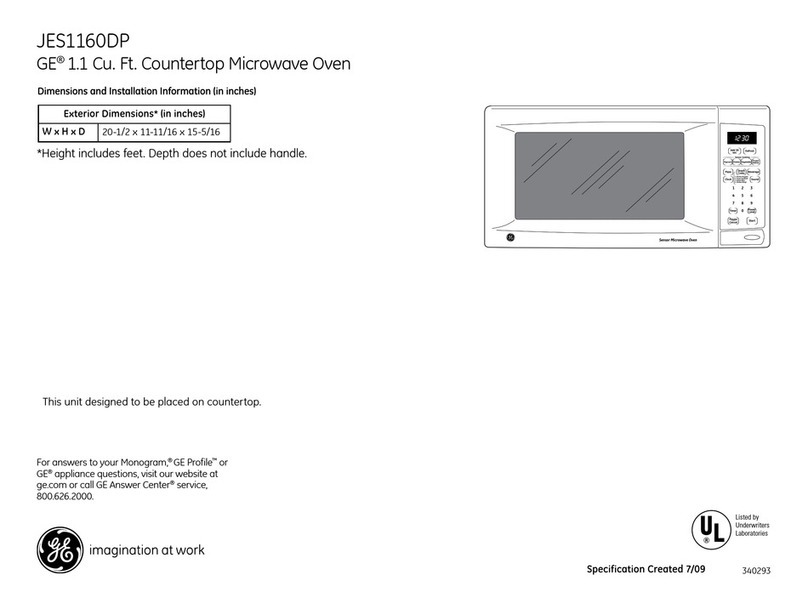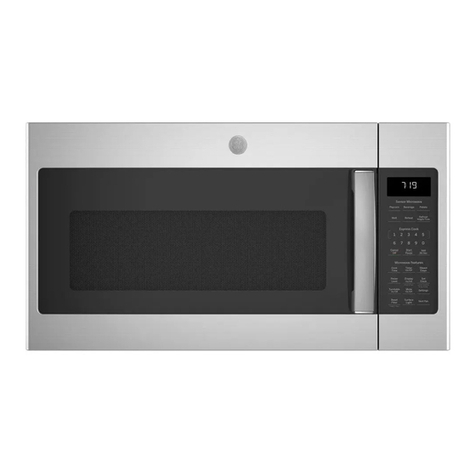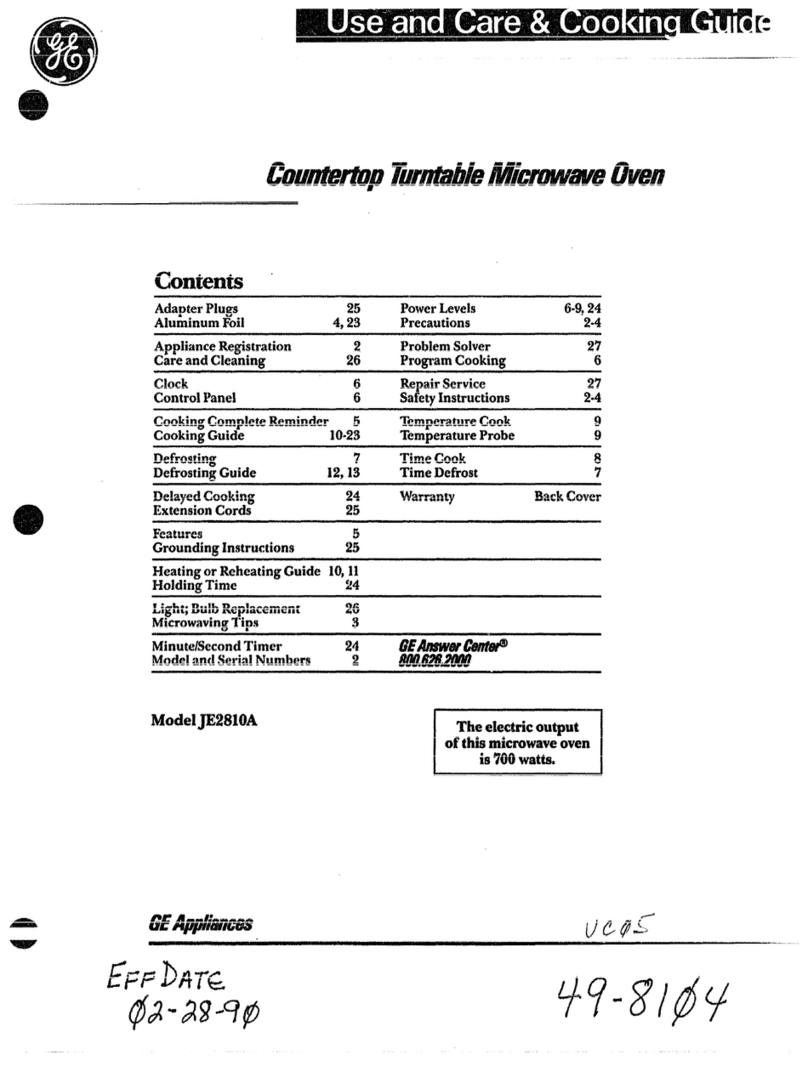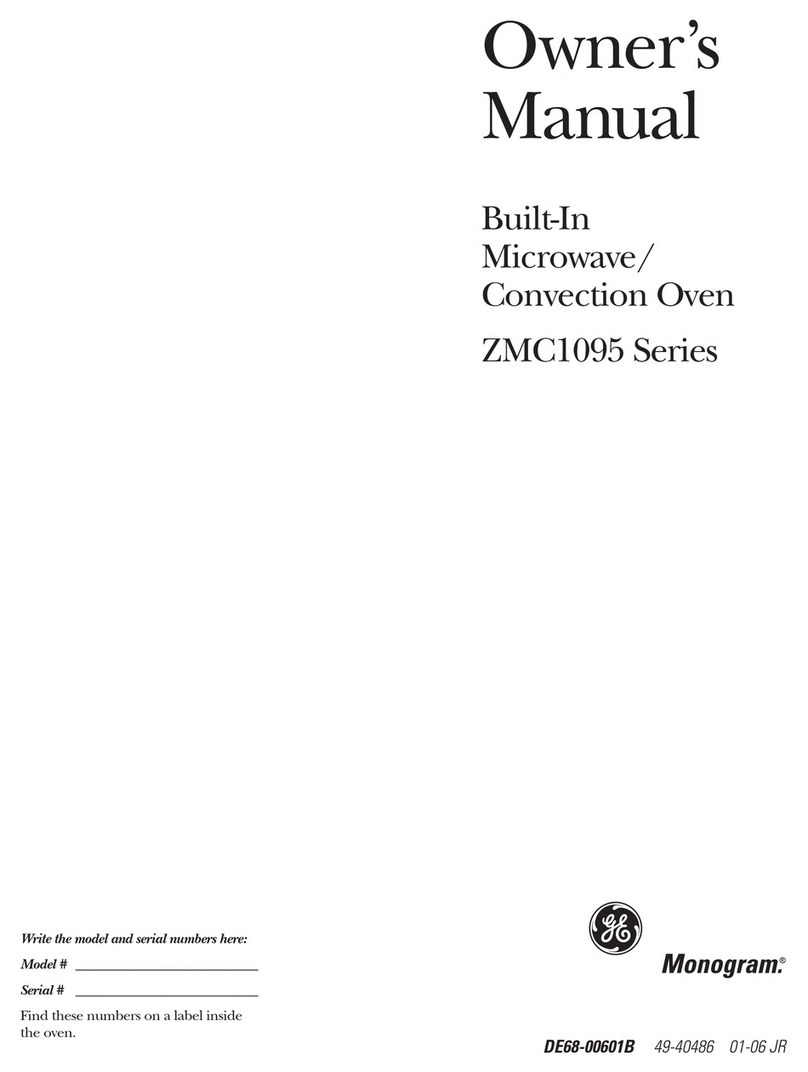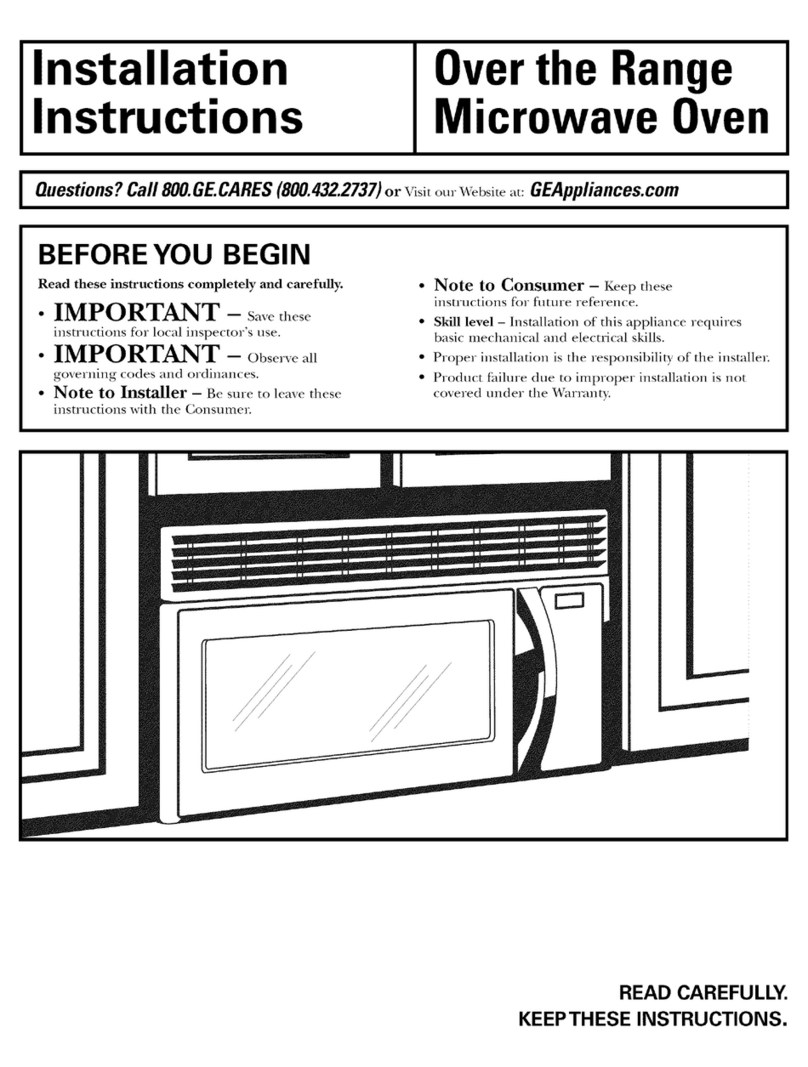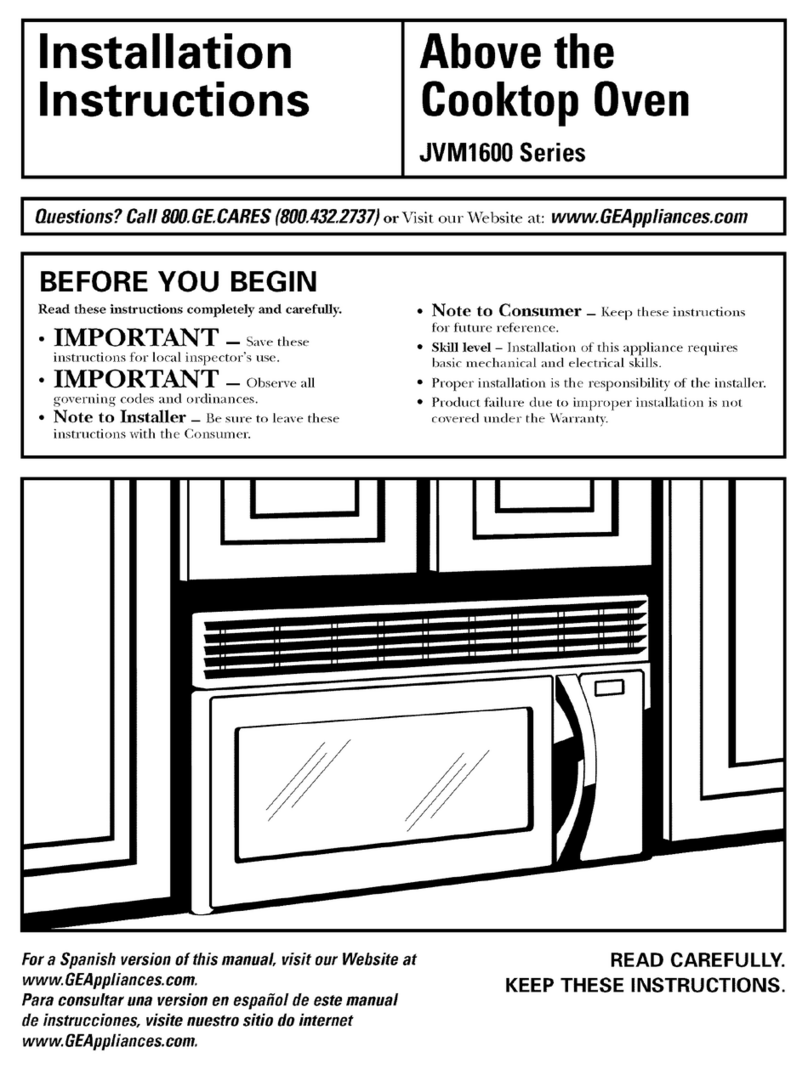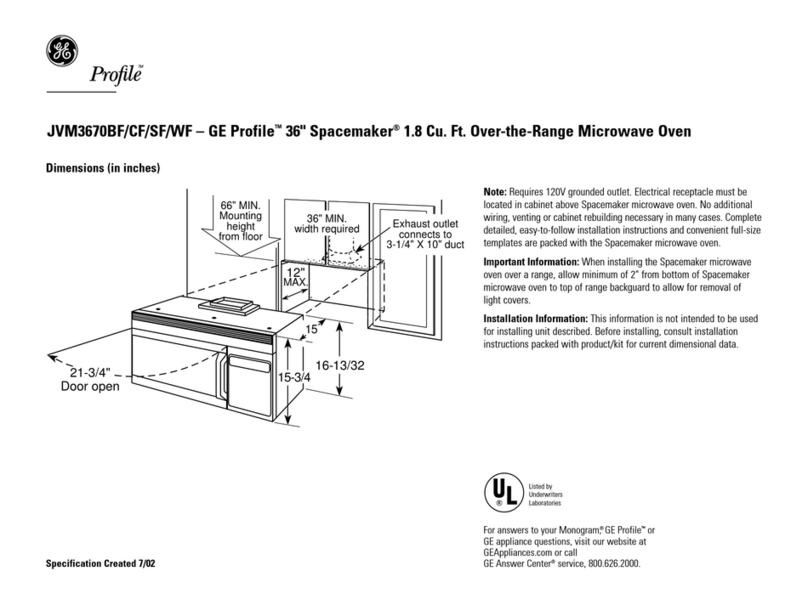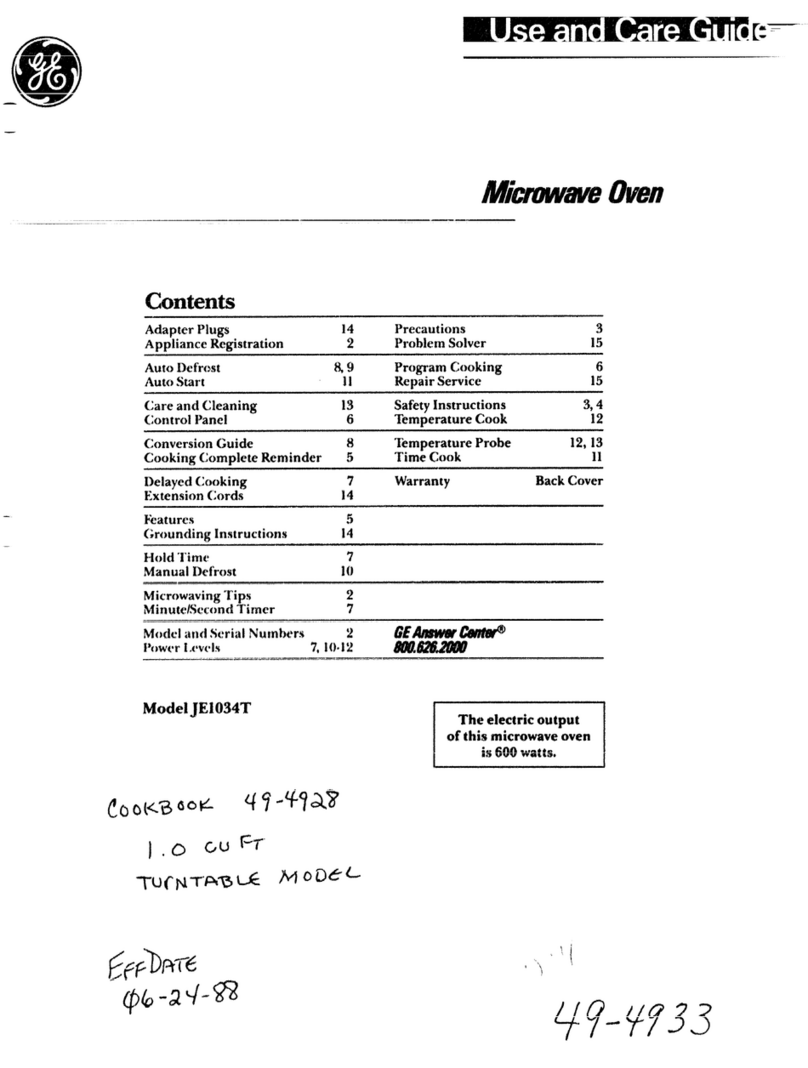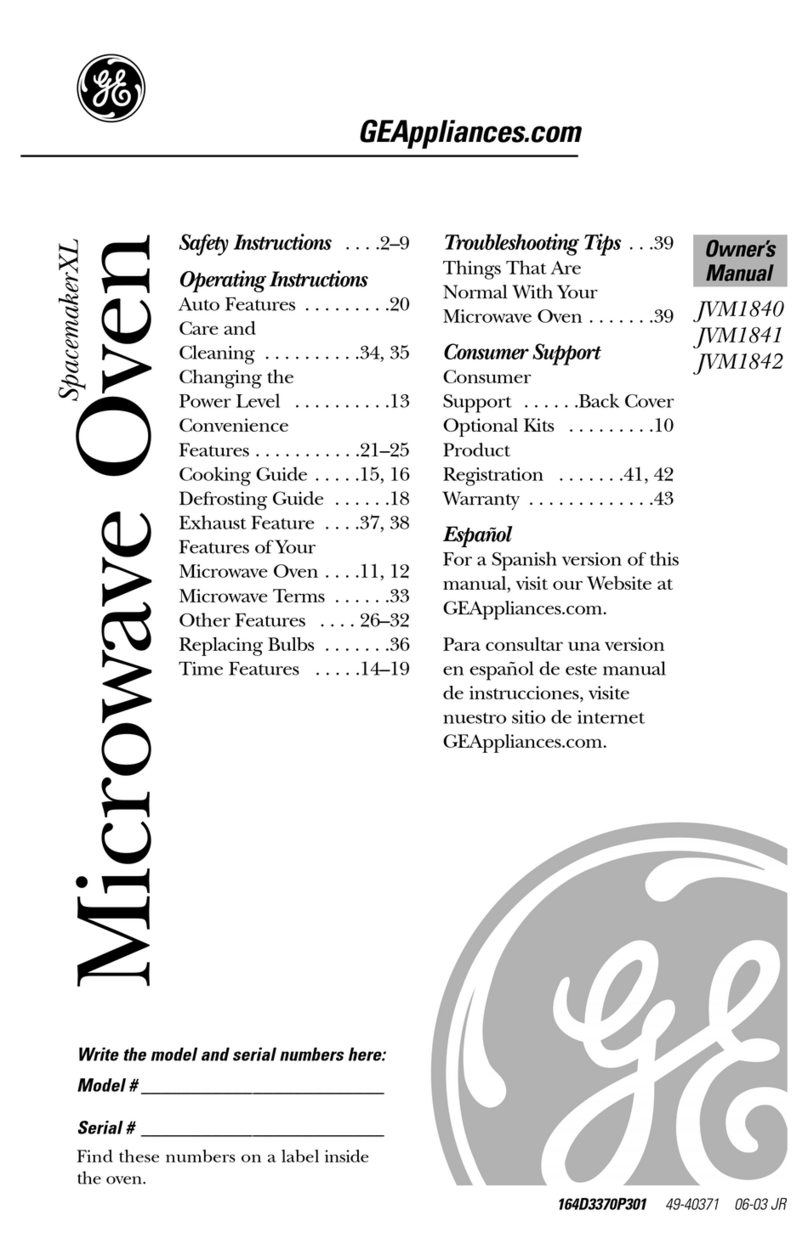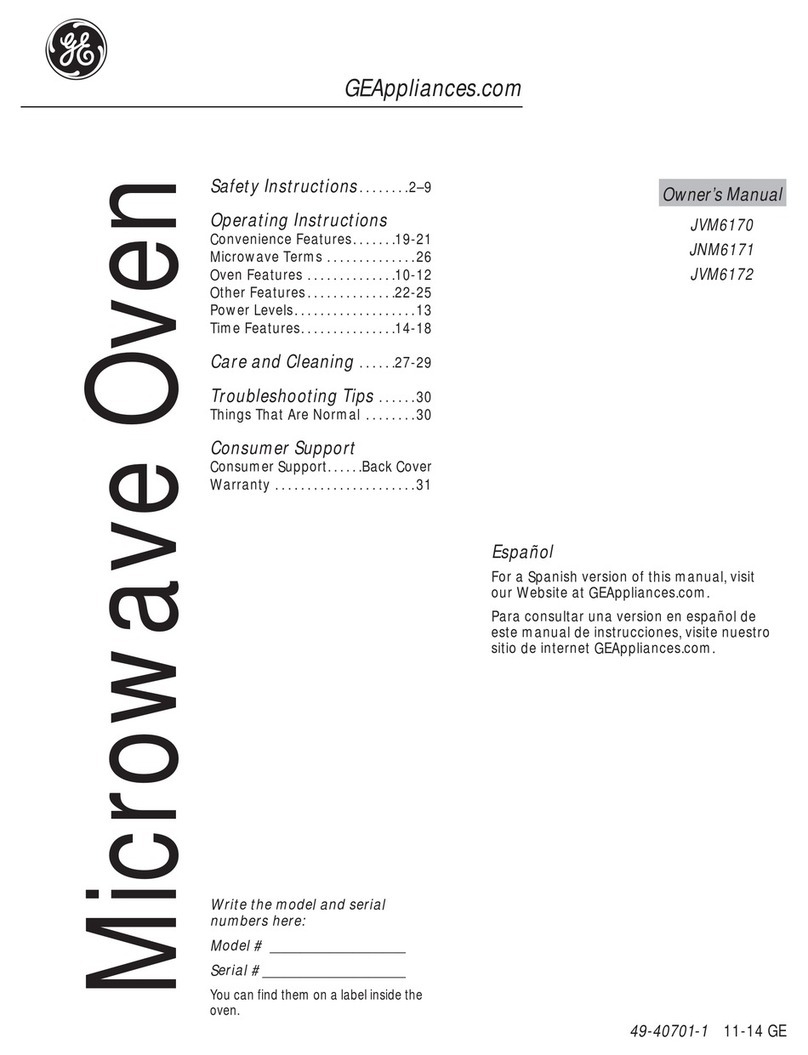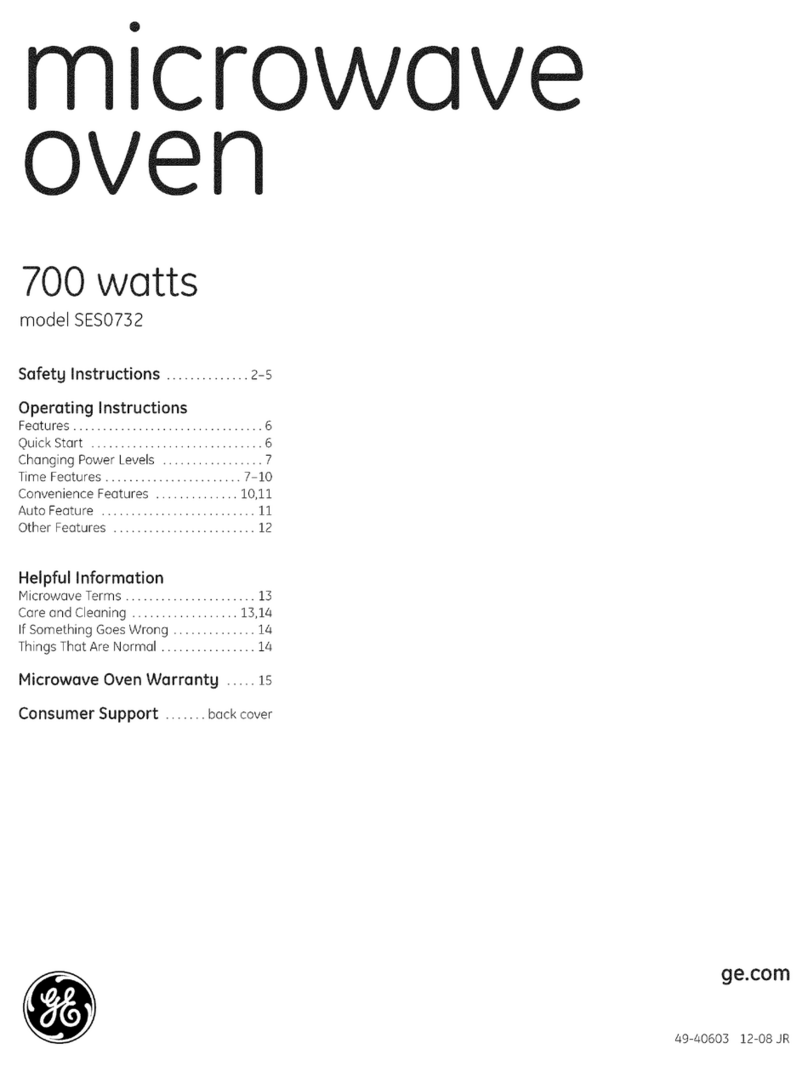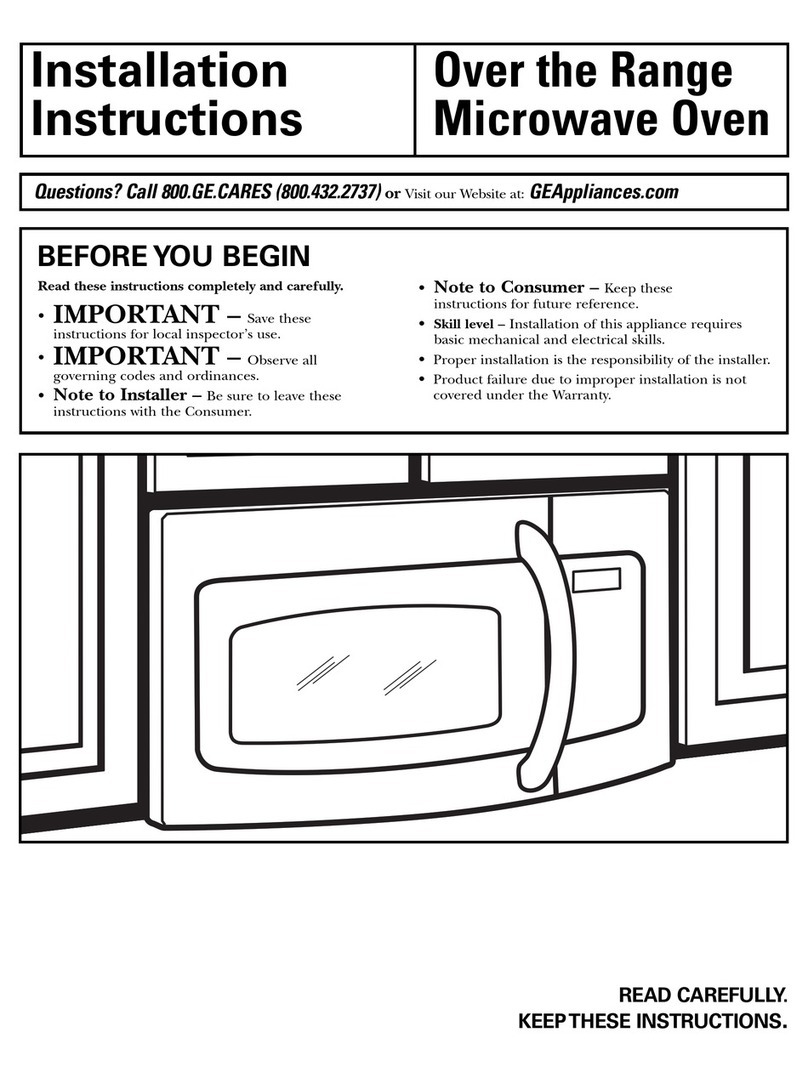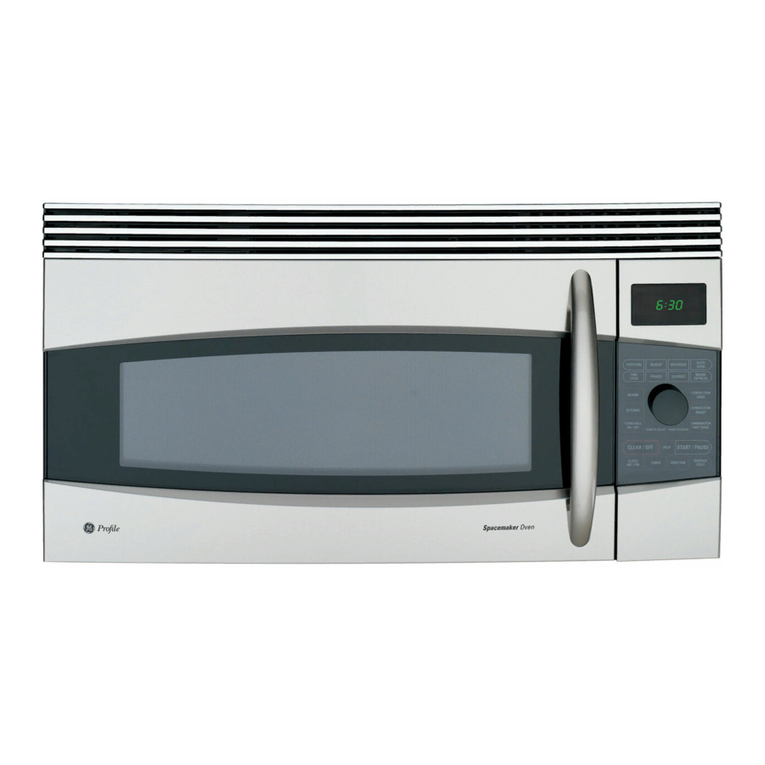GE JE640 Use and care manual

Turntable Microwave Oven
Safe~
instructions ...................3-5
Precautions to Avoid Possible Exposure
to Excessive Microwave Energy ...........2
Operating Instructions, Tips
Add
30 Seconds . . . . . . . . . . . . . . . . . . . . . . . . . . . . . . . . . . . . . . . . .
.
12
Aluminum
Foil..........................................4,
19
Auto Defrost . . . . . . . . . . . . . . . . . . . . . . . . . . . . . . . . . . . . . . . . . . 18, 19
Auto Start . . . . . . . . . . . . . . . . . . . . . . . . . . . . . . . . . . . . . . . . . . . . . . . . . . . . .
.
12
Beverage . . . . . . . . . . . . . . . . . . . . . . . . . . . . . . . . . . . . . . . . . . . . . . . . . . . . . . .
.
15
Child Lock-Out . . . . . . . . . . . . . . . . . . . . . . . . . . . . . . . . . . . . . . . . . . . . . . 10
Clock..................................................................9
ControlPanel..............................................8,9
CookingbyTime...................................1
1,
12
Cooking Complete Reminder .....................7
Cooking
Guide..............................................23
Defrosting by Time. . . . . . . . . . . . . . . . . . . . . . . . . . . . . . . . . . . . . . 17
DefrostingGuide.........................................22
Delayed Cooking . . . . . . . . . . . . . . . . . . . . . . . . . . . . . . . . . . . . . . . . .
.
10
Express Cook . . . . . . . . . . . . . . . . . . . . . . . . . . . . . . . . . . . . . . . . . . . . . . . . 12
Features
............................................................7
Glossary of Microwave
Terms..................2O
Heating or Reheating Guide .....................21
Hold Time . . . . . . . . . . . . . . . . . . . . . . . . . . . . . . . . . . . . . . . . . . . . . . . . . . . . .
.
10
MicrowavingTips..........................................6
Kitchen Timer . . . . . . . . . . . . . . . . . . . . . . . . . . . . . . . . . . . . . . . . . . . . . . . 10
Popcorn . . . . . . . . . . . . . . . . . . . . . . . . . . . . . . . . . . . . . . . . . . . . . . . . . . . . . . . . .
.
13
Power
Levels.....................................6,
10, 11
ProgramCooking...........................................7
Reheat . . . . . . . . . . . . . . . . . . . . . . . . . . . . . . . . . . . . . . . . . . . . . . . . . . . . . . . . . . .
.
15
Snacks . . . . . . . . . . . . . . . . . . . . . . . . . . . . . . . . . . . . . . . . . . . . . . . . . . . .
.
13, 14
Turntable
.................................................3,
4,7
~
●
✎✚
❞
✎
✎✎✎ ✎ ✎✎ ✎
✎
‘...:2;’
“.: .,’..
,,
$
i
@
:
.
.
.
.
Problem
SoIver..............................26
More questions
?...call
GE Answer Center
a
800.626.2000
Care
and
Cleaning
...........................24
Control Panel
................................................24
Turntable
.......................................................24
lnsta[lation
..................................25,26
Adapter
Plugs...............................................25
ExtensionCords...........................................26
Grounding instructions.......................25, 26
Consumer Services ..................27
ApplianceRegistration.................................2
Important Phone Numbers .......................27
Model and Serial Number Location ..........2
Warranty . . . . . . .
.................................Back
Cover
-
OAh,o”e”,,oowans
c
M/crowavepowerouput
(IEC-705
fist
Pmcedun)
GE Appliances

~LP
US
mLP
YOU...
Before using your oven,
read this guide carefully.
[t
is intended to help you operate
and maintain your new microwave
oven properly.
Keep it handy for answers to your
questions.
If you don’t understand something
or need more help, write (include
your phone number):
Consumer Affairs
GE Appliances
Appliance Park
Louisville, KY 40225
Write down the model and
serial numbers.
You’ll find them on a label inside
the oven.
These numbers are also on the
Consumer Product Ownership
Registration Card that came with
your microwave oven. Before
sending in this card, please write
these numbers here:
Model Number
Serial Number
Use these numbers in any
correspondence or service calls
concerning your microwave oven.
Be sure your microwave
oven is registered.
It
is important that we know the
location of your microwave oven
should a need occur for
adjustments.
Your supplier is responsible for
registering you as the owner.
Please check with your supplier to
be sure he has done so; also send in
your Consumer Product Ownership
Registration Card. If you move, or
if you are not the original
purchaser, please write to us,
stating model and serial numbers.
This appliance must be
registered. Please be certiin
that it is.
Write to:
GE Appliances
Range Product Service
Appliance Park
Louisville, KY 40225
If you received a
damaged oven...
Immediately contact the dealer
(or builder) that sold you the oven.
Save time and money.
Before you request
service...
Check the Problem Solver in the
back of this guide. It lists causes of
minor operating problems that you
can correct yourself.
All these things are normal
with your microwave oven.
● Steam or vapor escaping from
around the door.
● Light reflection around door or
outer case.
● Dimming oven
light
and change
in blower sound may occur while
operating at power levels other
than high.
“
Dull thumping sound while oven
is operating.
● Some TV-Radio interference
might be noticed
whi]e
using
your
microwave oven. It’s similar
~o
the interference caused by
other small appliances and does
not indicate a problem with
your oven.
PRECAUTIONS TO
AVOD
POSS~LE EXPOSURE
TO EXCESSIVE MICROWAVE ENERGY
(a)
Do
Not Attempt
to operate this
oven
with
the door open since open-door operation
can
result
in
harmful exposure to microwave
energy. It
is
important not to defeat or tamper
with the safety interlocks.
(b) Do Not Place any
object between the oven
front face and the door or allow soil or cleaner
residue to accumulate on sealing surfaces.
(c)
Do
Not Operate the
oven if it is damaged. It is
particularly important that
the
oven door close
properly and that there is no
damage
to the:
(1) door
@ertt)
(2)
hinges and latches
(broken
or loosened)
(3) door seals and sealing surfaces.
(d) The Oven
Shodd
Not
be adjusted or repaired
by anyone except properly qualified service
personnel.
&

A
~A~NG-Tor~ucetieriskof
burns,
&Iectric
shock,
fire,
injury
to persons
or,exposure
to
exqessive
microwave
energy:.
*
Read and
follow
th6
specific
“Precautions
tti
Avoid Possible, Exposure
to
Excessive Microwave
Energy” on the previous
page.
~
● This
appliance.must
&
grahded.
Connect
only
to
pFoperly
grounded
outiet.
See Grounding
fnstrnctions
section in the
backofthis
guide.
●
Use
M,appliance
o~y
for
ifiintended
tie
as
described
in
$his,guid@.
Do not use corrosive
chemicals or
vapors
in
Ms
appliance. This
microwave
oven
is specifically
desi~ed
to heat or
cook food, and
is
not intended for laboratory
or
industrial use.
●
For best
operation,
plug
this appliance
into
its
own
eleetricd
outlet,
to
prevent
fickering
of
lights,
b~ovving
of
fuse
or tripping of circuit
breaker.
●
WtaM
or
laeate
this
appliance
ody
’in
accordance with the provided Instigation
Instructions.
●
Be
eeti
b
plain
the
front
surface. of the
door three inches
ornrom
back from the
countertop edge to avoid accidental tipping
of
theapptianm
in normal
usage.
*Da
not
cover
or
blti
any
openings
on
the
appliance.
●
Do
not store this appliance outdoors.
Do
not use
this product near water—for example, in
a
wet
basement, near a swimming pool or near a sink.
●
This
microwave oven
h
not approved or tested
for marine use.
Q
Do not immerse power cord or
plug
in water.
●
Keep power cord away
from
heated surfaces.
●
Do
not operate any heating or cooking
apptiance
beneath this microwave oven.
o Do not mount
the
microwave oven over or near
any portion of a heating cooking
app~ance.
●
Do not mount this appliance over a sink.
‘oven@
in
opetidtin.
,’,:.
,7
,.
..,
.
Do
not
lit
power
tird hang over
e&e’of
kble
or
counter.
,...
@
Da
not
operate this
.appli~ce
if it
hti
a
damaged
powercordo
rplug,ifitis
not’ :
workingproperlyor
ifit has
been
damaged
~~•
or dmpp~., .” ‘‘
*
Do
not
operate
overi
tithout
the
~rntable
~‘
~
and
turntable,
suppart
seated and
~W
place.
●
Da
not
tiowturntable to be restricted
w
the
turntable
mnnot
ratate.
~,
‘
‘,
*
S*
door
surface
cl&ing
instructions
in the Care and Cleaning section(s) of this
guide.
● This
apptifice
should
be serviced on@ by
~~•
qutified
#erviwpersannel.
Contactnearest
authorized service, facility for examination,
Fepair
or adjustment.
● As with any
apptianm$
clos~
supervision is
n~essary
when used by children.
*
To,
reduee
the risk ‘of fire in the
av?n
cavity:
—Do not
ovemaak
food.
Carefully
a~end
appliance if
papr,
plastic or other combustible
materials are
placed
inside
the oven
to
facilitate
cooking.
~
-Remov;
wire twist-ties and
meti
han~es
from paper or plastic containers before placing
the~in
the oven.
—Bo
not
me
your microwave
oven
to
dry
newspapers.
—Do nat
USE
reeycled
paper products.
R~ycled
paper towels, napkins and
waxfid
paper
can
contain metal flecks which
may
cause arcing
or ignite. Paper
,products
containing nylon or
nylon
filaments should be avoided, as they may
also ignite.
—Do
not pop popcorn in your microwave oven
unless it is in a special microwave popcorn
accessory or unless you use popcorn labeled for
use
in
microwave ovens.
—Do nat
overeaak
potata~.
They
could dehydrate
and
catch fire, causing damage to your oven.
(connnaednetipge)
3

?
Some
produck~~h’
&
whole
eggs
and
s~~
containe~for
etiple;
clos@jars-wifl
explode and
shodd
not
be
heated
in
this
microwave
oven.
Such
use
of the microwave
oven
tiould
resuh
iq
injufi.
●
Avoid
heating
baby
food
in glass
jars,
even
without
theirlids;
especially meat and
egg
mixtures.
.
Do
not
defrost frozen
beverages
in narrow
necked
bottl~
(especially
carbonatti
beverages).
Even
if the containers opened, pressure can
build
up.
Ws
can cause the container
to
burst
possibly
resulting
in
injury.
o
Use
foti
only as directed
in
thk
,@de.
W
dinners maybe microwaved
in
foil
trays.less
than 3/4’’ high; remove
the
top foil
cover
and
return the
trqy
to the box.
Men
using
fofi
in the
microwave oven, keep tie foil at
least
1. inch
‘away from the
sides
of the oven.
●
Cookware
may
becorn~
hot
because of
heat transferred
from the
heated
food.
Pot
holders may be needed to
handle
the
cookware.
●
Sometimes,
the turntable
can
become too hot
to
touch.
Be careful touching the turntable during
and
after
cooking.
4
and Cleting
sectioti($)
forinstictidnso~
how to
.ciemti
inside of the
oven;:
.
:
~,
●
~etiornete~-~
not
use
a
tberrnumeter
in
food
you
arfl
microwaving
unlessth~~ermometer
is
desig?ed
orrecomrnended
foruse~
the
,
~
microwave
oven.
●
Plastic
cookw~
Pl~tic
qookware
designed
for
ticrowave
cootig
is
very
useful,
but
shodd
be
‘used
careMly.
Even microwave-safe plastic
m~y
not be
tis
t~lerant
of
overcooking conditions
w
are
‘
glas$
orcer~c
materi~sandrnay
soften
or.char
if
subjected to
short
period!
ofevercooking.
k
longer exposures to
overcwhng,
thefood
and
coo-~~e”cordd
ignite. For these reasons: .
1)
Use
micr?.wave-safe
plastics
ordyand
u%
them
in
strict compliance,
witb
thecobkwwc
manufacturer’s recommendations.
2)
Do
not
subject empty cookware to microwaving.
3)
Do
not
pefiit children
to
use.plastic
cookware
without complete supervision.
*
men
cooking pork,
follow
the
d~ections
exactiy
and always cook the
meat
to
an
internal
temperature of at least
170”F.
~is
assures that,
tithe
remote
possibtiity
that trichina maybe
present in the
meat,
it will be killed and meat
wi~
be safe to
eat.
●
Do
Mot
boti
eggs
in a microwave oven.
,Prossure
will buildup inside egg yolk and will
cause it to burst, possibly resulting in injury.
+
Foods with unbroken outer
‘skin”
such
as potatoes, sausages,
tomatoes, apples, chicken
tivers
and
other
giblets and
egg
yoks
(see
previous
cautio~)
shodd
be
pierced to&low
steam
to escape
during
cooking.

,.,
,,
:k
,
;:....:.
,, ,
●
NotaM
plastic
:-p
is
suihble
for
use
in
*
Hot
fotis
and
stm
u
@tise
.,..
ticmwave
ovem.~heckt
hqpachge
for
~~•
hwm:Ba
titi~f~l
when
opening “‘
proper.use.
“
.,
my
contie~pfh
ot:.fo@,,’.
,,
..,:,
,
,,
‘m
*
Spontanmus
botiin&Under
~
incl~ding
popcumbags,etioking:
mtiirt
s~id
circumstices,
pou~hes
and boxes. To prevent “..
>.
liqtids
may
start to boil
dting
or
poss~ble
injury, direct
steti
away
~
fmtrt
hands and face.
~
shordy
after
removal from
the
microwave
oven.
To prevent
bms
,:
.,.
:
,.. ,
from splashing
Mquid,
sttithe
fiquid
briefly before
removing
the
container
fiorn
the microwave oven.
SAW
~SE”’
‘
‘::
“‘“::
~~Ü‹
.
66Boil~ble*
cw~
pouches
and
tightly
cl~~
mSTRUCHONS
‘
plastic bags should be
sE$
piercd
or
vented as
directed
by package.
Hthey
are not, plastic
cardd
burst
during
or immediately after cootig,
Optional
ACC*OAH
possibly resulting in injury. Also, plastic storage
containers
shotid
be
at
least partially uncovered
Availabl&
at
ex~
cost from
your
GE supplier.
kause
they forma
tight
seal. When cooking
&AO19Ha@g
~t
allows this oven to be
with conttiers tightly covered with plastic wrap,
mounted under a cabinet.
remove covering
carefilly
and direct steam away
from hands and face.
To obtain service, see the Consumer Services page in
the back of this guide.
We’re proud of our service and want you to be
pleased. If for some reason you are not happy with the
service you receive, here are three steps to follow for
further help.
FIRST, contact the people who serviced your
appliance. Explain why you are not pleased. In most
cases, this will solve the problem.
NEXT, if you are still not pleased, write all the
details—including your phone number—to:
Manager, Consumer Relations
GE Appliances
Appliance Park
Louisville, KY 40225
FINALLY, if your problem is still not resolved, write:
Major Appliance Consumer Action
Panel
20 North
Wacker
Drive
Chicago, IL 60606
5

MICROWAVING TIPS
●
Make sure
all
cookware used in your microwave
●
Paper towels, waxed paper and plastic wrap
oven is suitable for microwaving.
Most glass can be used to cover dishes in order
to retain
casseroles, cooking dishes, measuring cups, custard moisture and prevent spattering. Be sure to vent
cups, pottery or china dinnerware which does not plastic wrap so steam can escape.
have metallic trim or glaze with a metallic sheen
be used. Some cookware is labeled “suitable for
microwaving”.
m~asuring
cup filled with one cup water—set the
measuring cup either in or next to the dish.
Microwave 1 minute at high. If the dish heats, it
should not be used for microwaving. If the dish
remains cool and only the water in the cup heats,
then the dish is microwave-safe.
can
c
Some microwaved foods require stirring, rotating
or rearranging.
Check the Cooking Guide.
●
Steam builds up pressure in foods which are
tightly covered by a skin or membrane.
Pierce potatoes, egg yolks and chicken livers to
prevent bursting.
If you use a meat thermometer while cooking,
make sure it is safe for use in microwave ovens.
VAWBLE POWER LEVELS (1-10)
Variable power levels add flexibility to your
microwave cooking. The power levels on your
microwave oven can be compared to the surface
units on a range. HIGH (Power Level
10)
or full
power is the fastest way to cook and gives you 100%
power. Each power
level
gives you microwave energy
a certain percent of the time. Power Level 7 is
microwave energy
7070
of the time. Power Level 3
is energy
30~0
of the time.
A high setting (10) will cook faster
but
may need
additional attention such as frequent stirring, rotating
or turning over. Most of your cooking will
be
done on
HIGH (Power Level
10).
A lower setting will cook
more
evenly
and with less attention given to stirring
or rotating the food. Some foods may have better
flavor, texture or appearance if one of the lower
settings is used. You may wish to use a lower power
level when cooking foods that have a tendency to boil
over, such as scalloped potatoes.
Rest periods (when the microwave energy cycles
of~
give time for the food to “equalize” or transfer heat
to the inside of the food. An example of this is shown
with Power Level 3—the defrost cycle. If microwave
energy did not cycle off, the outside of the food would
cook before the inside was defrosted.
Here are some examples of uses for various
power levels:
POWER LEVEL
I
BEST USES
Warm 1
Keeping food warm without
overcooking; softening butter.
6

FEATURES OF YOUR OVEN
?7
*
t
j:::;:..
$:::::::
:::*::::
:::::::::
*::::
1. Door Latches. 5. Removable
firntable.
Turntable must be in place
2. Door Screen.
Metal screen permits viewing of when using the oven. Cooking performance will
foods and keeps microwaves confined inside oven. be unsatisfactory without the turntable in place.
3.
Touch Control Panel and Display. See
Your The turntable may be removed for cleaning.
Touch Control Panel section for instructions. 6.
Removable
~rntable
Support.
4.
Automatic Cooking Guide.
Quick
reference codes 7.
Door Latch Release.
Press latch release button to
for many frequently prepared foods.
open door.
NOTE:
Rating plate, oven vent(s) and oven light are
located on the inside walls of the microwave oven.
Program Cooking
Use your Touch Control
Panel
to Time Defrost or Create your own programs to suit your individual
Time Cook 1 & 11 with choice of power levels from 1
cooking style. For example: use the Kitchen Timer
(lowest) to
10
(highest); to Reheat using a preset time to delay the start
of
Time Cook I & 11 or program a
and power level; to cook popcorn using a preset time hold time between Time Defrost and Time Cook I &
and power level; to time kitchen tasks with the Kitchen II. Set Time Cook I &
11
for a two-stage program
Timer; and to set the clock. using different times and power levels.
Cooking Complete Reminder
(For Time Cook and Time Defrost cycles)
To remind you that you have food in the oven, the oven will beep once a
minute until you either open the oven door or touch the CLEAWOFF pad.
7

Convenie~
f1
I
I I
BEVERAGE POPCORN
SNACKS
~
II
I
I
REHEAT
II
COOK
r
GUIDE BEHIND DOOR
Ex ress Cook -1-5 Minutes
‘1
i
3 4
5’
6
7
8
9
0-
—
I
1
II
I
J
I
POWER AUTO
LEVEL
START START
‘
E--
:
cti”~
OFF
~
I
1
REMINOER
8

The Touch Control Panel allows you to set the oven controls with the
touch of a finger.
It’s designed to be easy to use and understand.
1. DISPLAY.
Displays time of day, time or
temperature during cooking functions, power level
being used, cooking mode and instructions.
2. TIME COOK I & II. Microwave for a selected
amount of time using automatic Power Level
10 (High).
3.
TIME DEFROST.
Gentle thawing at automatic
Power Level 3 (Low).
4.
BEVERAGE.
Touch this pad to reheat a beverage.
No need to touch START, the oven will start
immediately.
5. REHEAT. Use Reheat for quick reheating of
a variety of foods using different times and
power levels.
6.
EXPRESS COOK.
Touch number pads 1
through 5 for 1 to 5 minutes of cooking. No need
to touch START, the oven will start immediately.
7.
SOUND ON/OFF.
Touch the SOUND ON/OFF
pad to turn the oven beeper on or off.
8.
ADD 30 SECONDS.
Press this pad for 30
seconds of cook time, to add 30 seconds to the
cook time as it’s counting down or for an “instant
on” for 30 seconds.
9.
POWER LEVEL.
Touch this pad before entering
another power level number if you want to change
from automatic Power Level 10 (High) for
cooking or Power Level 3 (Low) for defrosting.
10. AUTO START. Allows you to program your
oven to begin cooking at a preset time of
day—
up to a 12-hour
delay.
The Reminder feature can
be used like an alarm clock.
11.
AUTO DEFROST. Touch this pad and food
weight, then START. The oven automatically
sets power levels and defrosting time.
12. POPCORN. Touch this pad to cook prepackaged
microwave popcorn weighing 3.0 to 3.5 ounces.
No need to touch START, the oven will start
immediately.
13. SNACKS. Touch this pad, a code number and
weight or quantity of food to warm a variety of
snack foods.
14.
COOK.
Touch this pad, a code number and
weight of food for quick cooking of a variety
of foods using different times and power levels.
15. NUMBER PADS. Touch these pads to program
the microwave.
16. CLOCK. Touch this pad to enter time of day
or check time of day
while
microwaving. To set
clock, first touch CLOCK pad and then enter time
of day. For example, if time is 1
:30,
touch number
pads 1, 3 and O and
“
1
:30”
will appear in display.
Then touch START or CLOCK pad. To reset or
change time,
simply
repeat above process.
17. KITCHEN TIMER.
This feature uses no
microwave energy. It functions as either a kitchen
timer, as a holding period after defrost or as a
delay timer before time or temperature cooking.
18. START. After
all
selections are made, touch this
pad to start the oven.
19.
CLEAWOFF.
When touched, it shuts off the
oven and erases
all
settings (except time of day).
When held for three seconds, the Child Lock-Out
feature will be activated.
When You Plug in the Oven
The display panel displays “88888”, “18 POWER” and all of the oven
functions. After 15 seconds, all lights disappear and “RESET” appears
in the upper portion. Touch the CLEAWOFF pad, set the Clock and the
oven is ready for use.
This will happen any time there is a power outage.
9

HOW TO USE
T~
~TCHEN
T~ER
The Kitchen Timer Using a Holding Time
The Kitchen Timer has three timing functions:
The Kitchen Timer can also be used to program a
●
It operates as a minute timer.
“holding time” between microwave cooking functions.
The time can range from one second to 99 minutes
●
It can be set to delay cooking.
and 99 seconds. A holding or standing time may be
●
It can be used as a hold setting after defrosting.
found in some of your own recipes or in a cookbook.
The
Kitchen Timer operates without microwave energy.
How to Time a 3-Minute Phone Call Programming Delayed Cooking
m
Step 1:
Touch KITCHEN TIMER pad. To delay cooking up to 99 minutes and 99 seconds,
touch TIME COOK I &
11
and enter cook time. Touch
KITCHEN TIMER and enter number of minutes to
M
!’-
Step
2: Touch number pads 3,0 and O delay cooking. Touch START. Timer will count down
1
,
f
~
~
~
(for 3 minutes and no seconds).
to zero and cooking will begin.
E
Step
3: Touch START. Display shows
START
time counting down. The timer signals
when time is up.
How
to Defrost, Hold and Time Cook
Let’s say you want to defrost a frozen casserole for 15
minutes, hold for
10
minutes and then Time Cook for
25 minutes. Here’s how to do it:
m
Step
4: Set standing or hold time by
touching KITCHEN TIMER.
Step 1:
Take casserole from freezer and place in oven. Step 5: Touch 1, 0, 0 and O to hold for ten minutes.
m
m
Step
2: Touch TIME DEFROST.
m
Step
6: Touch TIME COOK I & 11.
Step 3: Touch pads 1,5,0 and O for Step 7: Touch 2,5,0 and O for 25 minutes of
15 minutes defrosting time. (Defrosting
cooking time.
is automatically set on Power Level 3
~1
Step
8: Touch START. As each
but can be changed by touching the
POWER LEVEL pad and the desired
m
fun~tion
is automatically performed,
oven display shows instructions
power level.) entered and the function. When time is
up, the oven signals and flashes “End”.
C~D
LOCK-OUT
You
may
lock
the control panel to prevent the
If
anyone tries to use the microwave, the display
microwave from being accidentally started or will show LOCK.
used by children. To
unlock
the control panel press and hold the
— -— To lock the controls press and hold the
m
CLEAWOFF pad for about three seconds.
CLEAWOFF pad for about three The display will show the time of day.
J
seconds. The display will show LOCK
and then return to the time of day. A
small “L”
will
be displayed to remind
you that the control panel is locked.
10
—.

Time Cook I
Time Cook allows you to microwave for a preset
amount of time.
Power Level 10 (High) is recommended for most
cooking, but you may change this for more flexibility.
See the Cooking Guide.
To become better acquainted with time cooking, make
a cup of coffee by following the steps below.
Step 1:
Fill a
cup
m
2/3 full of water,
add 1 teaspoon of
instant coffee and
stir to dissolve. Use
a cup that has no
//
!
c
metal decoration
&
Microwaving Tips section).
Place
cup in oven and close door.
m
Step
2: Touch TIME COOK I & II.
Step 3: Select your time. Touch pads 1,0 and O for
1
minute.
Because automatic Power Level
10
is recommended
for this cup of coffee, there is no need to change the
power
level.
(If Power Level
10
is not appropriate, see
“How to Change Power Level” below.)
m
Step 4: Touch START.
Step
5: When time is up, the oven signals and flashes
“End”. The oven, light and fan shut off.
Step
6: Open the door.
If you interrupt Time Cook to check the food, simply
close the door and press START to resume cooking.
If there is not time remaining on the timer you must
reset the timer to resume cooking.
How to Change Power Level When Setting
Time Cook I
1.
Press TIME COOK
I
& II.
2. Select cooking time.
3. Press POWER LEVEL.
4. Select power.
5. Press START.
Using the Time Cook II Feature
The Time Cook 11 feature lets you set 2 time cooking
functions within one program. This is ideal if you
want to change power levels during your cooking
operations. Here’s how to do it.
Step 1:
Place the food in the oven in a
microwave-
safe container and close the door.
m
Step
2: Touch TIME COOK 1 & II.
Step 3:
Select your first cook time. For example,
touch 2, 1 and 5 for 2 minutes and 15 seconds.
Step
4: Now is the time to change the power level
if you don’t want full power for TIME COOK 1.
(Press POWER LEVEL. Select power.)
Step
5: Touch TIME COOK I &
11
again.
The microwave oven will start and the time set for
“COOK TIME l“ will count down. Also, “POWER
10” or the power level selected for “COOK TIME I“
will be displayed.
At the end of “COOK TIME I“, the second power
level
is displayed and “COOK TIME II” is shown
counting down.
When time is up, the oven signals and flashes “End”.
The oven, light and fan shut off. Open the door.
If you interrupt Time Cook to check the food, simply
close the door and press START to resume cooking.
If there is not time remaining on the timer you must
reset the timer to resume cooking.
(cc>tlr;nued
next page)
Step
6: Set your second cook time.
Step
7: Change the power level for TIME COOK 11.
(Press POWER LEVEL. Select power.)
m
Step
8: Press START.
I
I

COO~G
BY
T~E
(continued)
The Express Cook Feature
The Express Cook feature is a short-cut method to
To Express Cook your food or beverage:
set time for 1-5 minutes at Power Level 10.
Touch a number pad (from 1 to 5) for
1
to 5 minutes
Expmm
Cook - l-5
Minties
of cooking at Power Level 10. For example, touch the
112131415
2
pad for 2 minutes of cooking time. No need to touch
START, the oven will start immediately.
The oven will signal and turn off automatically
when finished.
How to Use Auto
Stirt
The Auto Start feature allows you to program your Step
2:
Enter the time you want the oven to start.
oven to begin cooking at a preset time of day—
(Be sure your microwave oven clock shows the
up to a 12-hour delay.
correct time of day.)
Step 1:
Touch AUTO START pad.
Step
3: Enter your desired cooking program.
I I
. . ---
m
REMINDER
m
How
to Use Reminder
The Reminder feature can be used like an alarm
clock, without starting the oven.
Example: It is 7 a.m. and you must remember
to leave for a dentist appointment at 10 a.m.
m
Step 1:
Touch AUTO START pad.
REMINDER
Step 2:
Enter the time you want the oven to remind
you. (Be sure your microwave oven clock shows the
correct time of day. The reminder time can be set up
to 12 hours later.)
Step
4: Touch START pad.
The display will show the time you
entered. The time of day may be
displayed by touching the CLOCK
pad. The oven will automatically start
at the desired time.
Step
3: Touch START
pad. The reminder is now
~
_
~
set at the time you
programmed, and will
signal you at that time
with a beeping sound until
E
\T’~
\//
you open the door or touch the CLEAWOFF pad. The
display will show “REM” until the oven door is
opened or CLEAWOFF is touched. The REMinder
time may be displayed by touching the AUTO START
pad. The time-of-day may be displayed by touching
the CLOCK pad.
Add 30 Seconds
The Add 30 Seconds feature provides a convenient
wav
to extend
cooking
time
bv
30 seconds while the
Sound
OdOff
Feature
The Sound
OtiOff
feature allows you to turn the oven
bee~er
on or off.
. .
oven timer is counting down.
It
will add 30 seconds to
the time shown each time the pad is touched.
This pad may also be used as an express cook for 30
ti
ON/OFF
seconds of cooking. No need to touch START, the
oven will start immediately.
Touch the SOUND ON/OFF pad once
for sound. Touch the pad again for no
sound. If the sound has been turned off,
the display will show “OFF” and then
return to the time of day. A small “NO”
will be displayed.
12

The Popcorn feature is designed to be used only with
Step
2: Open oven door and place package of
prepackaged microwave popcorn weighing 3.0 to 3.5 popcorn in the center of the oven floor as directed by
ounces.
the package instructions. Close oven door.
Step 1:
Remove the outer wrapper from the
microwave popcorn.
m
Step
3: Touch POPCORN pad. No
need to touch START, the oven will
start immediately.
How to Adjust the Popcorn Program to Provide a Shorter or Longer Cook Time
If your favorite popcorn is not completely popped,
there is a simple adjustment you can make.
Touch the POPCORN pad
and then immediately
touch number pad 9. A
plus sign will appear on
the display beside the
word “POP”. The plus
If your favorite popcorn is overcooked, there is
another adjustment you can make.
Touch the POPCORN
sign indicates 20 seconds more cooking time is being
provided.
No need to touch START, the oven will start
immediately. If the oven beeps before you were
able
to
touch 9, touch the CLEAWOFF pad and begin again.
!=tl—ll=t+
pad and then
1
~11
immediately touch
number pad 1. A minus
sign
will
appear on the
display beside the word
“POP”. The minus sign indicates 20 seconds less
cooking time is being provided.
No need to touch START, the oven will start
immediately. If the oven beeps before you were able to
touch 1, touch the
CLEAWOFF
pad and begin again.
With the Snacks feature, the oven automatically sets
Use the Snacks Code Guide. Touch the SNACKS pad.
the microwaving times and power levels for you.
For codes
1
to 4 enter the quantity of food. For codes
5 and 6 enter the food weight in ounces. Then touch
the START pad.
The oven calculates time and changes power levels
during microwaving to give even results.
How to Use the Snacks Feature (Snacks Codes 1 to 4)
NOTE: See the next page on how to use Snacks
Codes 5 and 6.
Step 1:
Remove the food from the package, place in
the oven on microwave-safe dish and
ciose
door.
m
Step
2: Touch the SNACKS pad.
Ste~
3: Touch number
~
‘ollsandmuffinsThe
E
pa~of
desired food code.
For example, touch
number pad 1 for bread,
code number and food
type you selected
will
appear on the display.
“ENTER” will flash.
Step
4: Touch number pad to enter the quantity of
food. For example, touch 2. After 5 seconds “START”
flashes on the display.
m
Step
5: Touch the START pad. Oven
will begin microwaving. Touching the
SNACKS pad during microwaving will
display the remaining time. When
done, oven displays “End”.
13
m
1

SNAC=
(continued)
How to Use the Snacks Feature (Snacks Codes 5 and 6)
NOTE: See the previous page on how to use
Snacks Codes 1 to 4.
Step 1:
Remove the food from the package, place in
the oven on microwave-safe dish or container. Close
the oven door.
M
Step
2: Touch the SNACKS pad.
I
I
Step 3: Touch number
~
pad-of desired food code.
For example, touch
~Q~/,m
s
number pad 5 for soup.
ENER
The code number and
‘m
~DE
I
food type you selected
will appear on the display.
“ENTER WEIGHT” will flash.
Step
4: Touch number pad to enter food weight. For
example, touch 1 and 2 for 12 ounces. After 5 seconds
“START” flashes on the display.
Step
5: Touch the START pad. Oven
will begin microwaving. Touching the
SNACKS pad during microwaving will
display the remaining time. When
done, oven displays “End”.
SNAC~ CODE
G~E
Codes 1 to 4
For warming foods with Snacks Codes
1
to 4 use the following guide:
Quantity
Food Code Display Limit (QTY) Comments
Bread, rolls,
I
bREd
1 to 4
Use paper towel or
muffins
microwave-safe plate.
Sandwiches
2
SANdw
I
to 2
Use paper towel or
microwave-safe plate.
Pizza
3
PIZ
I
to 4
Use microwave-safe plate.
(leftover slices)
I I I I I
Dessert Toppings
4
TOP
1 to 4
Use microwave-safe dish.
Codes 5 and 6
For warming foods with Snacks Codes 5 and 6 use the following guide:
Weight
Food Code Display
Limit
(OZ)
Comments
I
11
1
soup
5
SOUP
8
to 32 OZ.
Use microwave-safe dish.
Cheese Dip
6
CHEEZ
4 to
16
OZ.
If container is microwaveable,
follow instructions on container;
or use microwave-safe dish.
14

The Reheat feature is a short-term program to automatically reheat a
previously cooked food. The oven turns off automatically after a preset
amount of time.
Touch just three pads to use Reheat codes
1
to 6 to reheat many popular
foods. See the Reheat Guide below.
Reheat To Reheat More Than One Serving
The Reheat program makes it a snap to reheat many
popular foods. Choose a code number from 1 to 6
(see Reheat Guide below).
R
Step 1:
Touch REHEAT pad.
I
I
Step
2: Touch a number pad from 1 to 6 to select a
food group.
m
Step
3: Touch START pad. Oven
will signal and turn off automatically
when finished.
Reheat codes
I
through 5 let you heat up to three
servings. To add more than one serving, just touch
number pad 2 or 3 right before touching START.
The serving size may even be changed or added after
touching START. Just touch number pad 2 or 3.
“SERV”
and a number will be displayed briefly to
show that serving size has been changed.
Reheat Guide
r
Code
I
4
b
5
6
Serving Time per
Display Size
Serving
PASTA
I
1-3
I
2min.
15sec.
MEATS 1-3 1 min. 15 sec.
VEGS
1-3 1 min. 15 sec.
BEV 1-3
1 min.
20
sec.
SAUCE
1-3
1
min. 45 sec.
PLATE
—
3 min. 15 sec.
I
Foods Recommended
Pasta
Meats, casseroles, pizza
Fruits and vegetables
Beverages
I
Sauces
and gravies
I
2 to 3 foods, 4 oz. each
The Beverage program makes it simple to reheat a The serving size is automatically set at 1, but can be
cup of hot chocolate or other beverage. Use a cup that changed by touching number pad 2 or 3 right after
has no metal decoration and is microwave-safe (refer touching the BEVERAGE pad. The oven will signal
to the Microwaving Tips section). and turn off automatically when finished.
Touch BEVERAGE pad. No need
=
immediately
to touch START, the oven will start
15

COOK
With the Cook feature, the oven automatically sets
The oven calculates cooking time and changes power
the cooking times and power levels for you.
levels during cooking to give even cooking results.
Use the Cook Code Guide. Touch the COOK pad.
Touch a number pad from 1 to 9 to select the desired
food group. Enter the food weight in ounces, then
touch the START pad.
How to Use the Cook Feature
Step 1:
Remove the food from the package, place in
the oven on microwave-safe dish and close door.
m
Step
2: Touch the COOK pad.
I
I
Step
3: Touch number
pad of desired food code.
For example, touch
number pad 1 for canned
~~;~
vegetables. The code
number and food type you
E
If
1-1-
I
!f
c
Q
f
/
COOE
selected will appear on the
display. “ENTER WEIGHT” will flash.
Step
4: Enter weight. For example, touch
1
and 8
for 18 ounces. After 5 seconds “START” flashes
on the display.
m
Step
5: Touch the START pad. Oven
will begin cooking. Touching the
COOK pad during cooking
will
display
the remaining Cook time. Oven
displays “End” when cooking is done.
Cook Code Guide
I
Cook
Food Code
Fresh
3
Vegetables
Potatoes
14
I
Fish
5
Chicken
6
Pieces
Ground Meat
7
(Beef, Pork,
Turkey)
Bacon
8
Pizza
9
(frozen
microwaveable)
Weight
Limit
(OZ)
Comments
4
to
20
oz.
Use microwave-safe casserole or bowl.
Cover with lid or
Plastic
wrap.
4 to 16 OZ.
Use microwave-safe casserole or bowl.
Follow package instructions for adding water.
Cover with lid or plastic wrap.
4 to 16 OZ.
Use microwave-safe casserole or bowl.
Add 2 tablespoons water for each serving.
I
Cover with
lid
or plastic wrap. -
8 to 40 OZ.
Pierce skin with fork. Place side by side on oven floor.
4 to 16 OZ.
Use oblong, square or round dish.
Cover with plastic wrap.
4 to 32 OZ.
Use oblong, square or round dish.
Cover with wax
paper.
8
to 32 OZ.
Use round casserole dish. Crumble meat into dish.
Cover with wax paper.
2 to
10
oz. Layer strips on a plate, 4 to a layer.
Cover each layer with a paper towel.
4 to 16 OZ.
Follow
package instructions to prepare pizza
for
microwaving.
16

DEFROST~G
BY
T~E
Time Defrost (Power Level 3)
Time Defrost is designed for speedy thawing of
To become better acquainted with the defrost
frozen food and is one of the great advantages of a
function, defrost a 10 oz. package of frozen
microwave oven.
strawberries by following the steps below.
Use
the Time Defrost setting to quickly thaw foods
Step 1:
Place a package of frozen strawberries in
such as bread, rolls, vegetables, fruits and frozen the oven and close door. Be sure package contains
dinners. The Auto Defrost setting is preferred for
no metal.
meat and poultry because the
ov=n
sets the defrosting
m
Step
2:
Touch TIME DEFROST.
time and power-levels for you.
●
Power Level 3 is automatically set when you
press Time Defrost pad, but you may change this
for more flexibility.
●
See the Defrosting Guide for defrosting help.
How to Change Power Level
1.
Press TIME DEFROST.
2. Select defrosting time.
3. Press POWER LEVEL.
4.
Select
power.
5. Press START.
1J
Step
3: Select one half of the total defrosting time
recommended. For example, touch pads 4, 0 and O
for 4 minutes.
m
Step
4: Touch START. When the
cycle is completed, the oven signals
and flashes “End”, then automatically
shuts off.
Step
5: Turn the package over,
close
the door and
repeat Steps 2 and 3 to set remaining half of
defrosting time. Touch START.
Step
6: When the oven signals and flashes “End”,
o~en
the door. remove the
package
and separate
s~rawberries
to finish
defro-sting.-
Defrosting Tips
e
●
Foods frozen in
Daper
or
5
‘
‘*:~~z’L’:
.:’:a
‘
~
●
Fami
Iy-size,
pre-packaged frozen dinners can be
—*
For even defrosting, some
plastic can be
d~fr~sted
in foods need to be
b;oken
the package. Tightly
closed
up or separated part of
packages should be slit, the way through the
pierced or vented,
A~ER
defrosting time.
food has partially defrosted,
●
Foods that spoil easily, such as
milk,
eggs, fish,
as directed by package.
Plastic storage containers stuffings, poultry and pork should not be allowed to
sit out for more than one hour after defrosting. Room
should be at least partially temperature promotes the growth of harmful bacteria.
uncovered.
●
Check the Defrosting Guide for other defrosting tips.
defro~ted
and
microwa~ed.
If the food is in a foil
container, transfer it to a microwave-safe dish.
-.
Questions and Answers
Q. When I press START, I hear a dull thumping Q. Can I defrost small items in a hurry?
noise. What is it? A. Yes,
but they will need more frequent attention
A.
This sound is normal. It is letting you know the than usual. Raise the power level after entering
oven is using a power
level
lower than
10
(High). the time by touching the desired power
level
pad.
Power Level 7 cuts the total defrosting time in
about 1/2; Power Level 10 cuts the total defrosting
time to approximately l/3. During either, rotate or
stir food frequently.
17
m
.

A~O
DEFROST
Auto Defrost
With the Auto Defrost feature, the oven
Use the Auto Defrost Guide. Enter the food weight in
automatically sets the defrosting times and
pounds and tenths of a pound (see Conversion Guide
power levels for you.
below). Then touch START pad.
The oven calculates defrosting time and changes power
levels
during
defrosting to give even defrosting results.
How to Set Auto Defrost
Before you begin,
check
the guide located on the
inside front of oven when you open the door.
It shows minimum and maximum food weights for
a variety of foods. You will need to know your food
weight before setting Auto Defrost.
Step 1:
Remove food from package,
place
in oven on
microwave-safe dish and close door.
m
Step
2: Touch Auto Defrost pad.
Step
3: Enter weight. For example, touch number
pads 1 and 2 for weight of 1.2 pounds
(1
pound, 3
ounces). See Conversion Guide below. After 3
seconds “START” flashes.
m
Step
4:
Touch START pad. Display
shows defrost time counting down.
‘::::::inm
Twice during defrosting,
the oven beeps 4 times —
the Auto Defrost Guide
1
for what to do at the first
1
and second signal.
Then close the door and
touch START pad.
When defrosting time is completed, “End” flashes
and oven beeps 4 times. “End” remains on display
and oven beeps every minute until door is opened or
CLEAWOFF pad is touched.
Stind
Time
Conversion Guide
After Auto Defrosting, meat needs to stand in order to
let the inside defrost. You may take the food out of the
oven if you wish. Stand time recommendations are
given in the Auto Defrost Guide.
F
If the weight of food is stated in
I
Ounces
Pounds
I
1-2
I
.1
I
3
?
.&
&s
3
.-
67
,4
8
.5
9–10
.6
w
18

AUTO DEFROST
G~E
RECOMMENDED MIN.-MAX.
FOODS WEIGHT
FIRST SIGNAL
!
SECOND SIGNAL
STAND
T~E
Chops
0.1 -6.0 lbs.
Turn over.
Separate and shield
where necessary.
5
minutes
Frankfurters, Sausage 0.1 -6.0 lbs.
Separate.
Remove defrosted
pieces.
2 minutes
Ground Meat 0.1 -6.0 lbs.
Turn over.
Remove defrosted areas
and break apart.
5 minutes
Beef Patties
I
0.1
-6.Olbs.
Turn over.
]
Separate patties.
5 minutes
Roast
I
0.1 -6.0 lbs.
I
Turn over and
Shield if necessary.
shield.
90
minutes
Ribs
0.1 -6.0 lbs.
Turn over.
Remove defrosted
pieces. Shield if
necessary.
Turn over.
Turn over and Separate and remove
separate. defrosted pieces.
10 minutes
5 minutes
5 minutes
Whole Chicken 0.1 -6.0 lbs. Turn over and Turn over and shield.
shield.
10
minutes;
run cold water
in cavity.
Turkey Breast 0.1 -6.0 lbs.
(breast side up)
Turn over.
Shield where
necessary. 20 minutes
in refrigerator;
run cold water
in cavity.
Chicken Pieces
0.1 -6.0
lbs.
Turn over.
Separate and remove
defrosted pieces. 5 minutes
Comish Hens (whole) 0.1 -6.0 lbs.
10 minutes;
run cold water
in cavity.
I
Comish Hens (split) 0.1 -6.0 lbs.
5 minutes
Turn over.
Separate and remove
defrosted pieces.
Separate.
Separate and remove
defrosted pieces.
5 minutes
5 minutes
Hold under
cold running
water.
Whole Fish 0.1 -6.0 lbs.
Turn over and
shield tail and
head.
Edges
or
thin
~eas
of meat
will
defrost more rapidly than other areas.
After first or second signal, shield warm areas with
small
pieces of foil.
19

GLOSSARY OF MICROWAVE TERMS
When adapting recipes for the microwave, it is
best to start with a familiar recipe. Knowing how
the food should look and
tiste
will help when
adapting recipes for microwaving. Foods that
require browning or crisp, dry surfacw will cook
better in regular ovens.
●
Moist foods, such as vegetables, fruits, poultry and
seafood, microwave well.
●
Rich foods, such as bar cookies, moist cakes and
candies, are suitable for microwaving because of
their high fat and sugar content.
●
Reduce regular oven cooking times by 1/2 to 1/3.
Check food after minimum time to avoid
over-cooking.
●
Small amounts of butter or oil can be used for
flavoring, but are not needed to prevent sticking.
●
Seasonings may need to be reduced. Salt meats and
vegetables after cooking.
Covering.
In both
regular baking and microwave
cooking, covers hold in moisture, allow for more
even heating and reduce cooking time. In regular
ovens, partial covering allows excess steam to escape.
Venting plastic wrap or covering with wax paper
serves the same purpose when microwaving.
Venting.
After covering a dish with plastic wrap,
you vent the plastic wrap by turning back 1 comer
so excess steam can escape.
Arranging Food in Oven.
When baking in regular
ovens, you position foods, such as cake layers or
potatoes, so hot air can flow around them. When
microwaving, you arrange foods in a ring, so that
all
sides are exposed to microwave energy.
Stirring.
In range-top cooking, you stir foods up from
the bottom to heat them evenly. When microwaving,
you stir cooked portions from the outside to the
center. Foods that require constant stirring will need
only occasional stirring when microwaving.
~rning
Over.
In range-top cooking, you turn over
foods, such as hamburgers, so both sides can directly
contact the hot pan. When microwaving, turning is
often needed during defrosting or when cooking
certain foods, such as frozen hamburgers.
Standing Time.
When you cook with regular ovens,
foods such as roasts or cakes are allowed to stand to
finish cooking or to set. Standing time is especially
important in microwave cooking. Note that a
microwaved cake is not
placed
on a cooling rack.
Shielding.
In a regular oven, you
shield
chicken
breasts or baked foods to prevent over-browning.
When microwaving, you use small strips of foil to
shield thin parts, such as the tips of wings and legs
on poultry, which
would
cook before larger parts.
Arcing.
Sparks caused by too much metal in the
microwave oven or metal touching the side of the
oven or foil that is not molded to food.
Prick Foods to Release Pressure.
Steam builds up
pressure in foods that are tightly covered by a skin or
membrane. Prick foods, such as potatoes (as you do
before regular oven cooking), egg yolks and chicken
livers, to prevent bursting.
Rotating.
Occasionally, repositioning a dish in the oven
helps food cook more evenly. To rotate 1/2 turn, turn the
dish until the side that was to the back of the
oven
is
to
the front. To rotate 1/4 turn, turn the dish until the side
that was to the back of the oven is to the side.
Basic Microwave Guidelines
Density of Food.
In both regular baking and
Piece Size.
Small pieces cook faster than large ones.
microwave cooking, dense foods, such as potatoes, Pieces that are similar in size and shape cook more
take longer to cook than light, porous foods, such as evenly. With large pieces of food, reduce the power
rolls, bread or pieces of cake. setting for even cooking.
Round Shapes.
Since microwaves penetrate foods to
Shape of Food.
In both types of cooking, thin areas
about I inch from top, bottom and sides, round shapes cook faster than thick areas. This can be controlled in
and rings cook more evenly. Comers receive more microwaving by placing thick pieces near the outside
energy and may overcook. This may also happen edge and thin pieces in the center.
when cooking in a regular oven.
Starting Temperature.
Foods taken from the freezer
Delicacy.
Foods with a delicate texture, such as or refrigerator take longer to cook than foods at room
custards, are best cooked at lower power settings to temperature. Timings in our recipes are based on the
avoid toughening. temperatures at which you normally store the foods.
Natural Moisture
of food affects how it cooks. Very
Quantity of Food.
In both types of cooking, small
moist foods cook evenly because microwave energy is amounts usually take less time than large amounts.
attracted to water molecules. Food that is uneven in This is most apparent in microwave cooking, where
14
L-
--.
._e+.A..=s-q.~~&=.
+..+-tit=Jw==e=;..;.L
.-.–..-..
- ...- .-.:
.;
. .
.
.,
k--
..6
mq...sol,_,_/_...-.--—--
—-:-. .._-. ..
L.a.>..
– ...=---------
J:-=
-*l.
--l
----
.,m.
t.k=q=a=.->--—.
-...
.
.
..:..,,
_=;,*;.,*
>..&~...*=;.==+.a-==+.*..:<.=:::i=*=*L<<<=,=.=<+.=>T=+T==G=%ia%=
.
.
.
.
.
.
.
.
.. .
.
.
.
.
.
.
.
.
.
.
.
.
.
.
.
.
.
.
.
.
.
.
.
.
.
.
.
.
.
.
.
.
.
.
.
.
.
.
..
.
.
.
.
...
.
.,..---==..w.---x..
..->.,..=
z,:=:.~,+
.~,>.
>.a.
>=-&.~
,.c,.=,
-:......:,..-.:=
T.-.7
=.-m=
.:>.:
%>:..=:=.=,=.=,---==.=.~-.:,,...n.-.>-..B-a=--->j-
-.
-.+-.
>-.%=%~:~>&>>;a>Aa.A.=..=..=L.~..-.=-.=
-.,.....
-----<.
-=...=...
~.
~=
.~=:-.
..&.s.e....*...:=::.<*:...=...,...,...,F.,.
..,
..s
..:----
.
.
.
.
.
.
.
.
.
.
.
.
.
.
.
.
.
.
.
.
.
.
.
.
.
.
.
.
.
.
.
.
.
.
..
.
.
.
.
.
.
.
.
.
.
.
.
.
.
.
.
.
.
.
.
.
.
.
.
.
.
.
.
.
.
.
.
.
.
.
..
.
..-
..=----------
.... -..=..=+..*
.=.*.......=...,=4,..*=..>,-=..==-:<..-.=<..,--.a,.~
..—
.~---=-.-.
.
.
.
..
.-=.-..
,.-,.-....s..:....:..
.
.
.
.
.
.
.
..
.
,,---------
,-..
:--..
:...-..--...
-.._.._..
>=...=.<,<<<=,<==~..=..,.,-<=.,===.,2<=.,>c~.,
:-...=-...=...-,=>
=.-..,
.
.
.
.
.
.
.
.
.
.
.
.
.
.
——
,..
,-
..=-.-
.+.=:,.-:
~:::=,:,.~=:<=,:.:..
=.<....
>_.:=
:_~.,=.:<~:.,:.
.
.
.
.
..
.
.
.
.
.
.
.
._.
a
.
...
....
.
..
.
..,
..
-.
->
>,>
>->
>->
.-.
.-,.
>=------
.
.
.
.
.
.
.
.
.
.
.
.
.
.
.
.
.
.
.
.
.
.
.
.
.
.
.
.
.
.
.
.
.
.
..
.
.
.
...
.
.
.
.
.
.
.
.
.
.
.
.
.
.
.
.
.
.
.
.
.
.
.
.
.
.
.
.
.
.
.
.
.
...
..
.
.
..
.
.
.
.
.
.
.
.
.
.
.
.
.
.
.
.
.
..
.
.
.
.
.
.
.
.
.
.
.
.
.
.
.
.
.
.
.
.
_...
...
=.—.
–.=e.>--&>=2+.+a.:.a.+....<....<<>A..e-.==-<>A.
:.;:.--
.-:
,-
,.
,-
,:
.-
,-
,
,
,
,
““:”
”.:-:
-s...z..z.,:s:+s:a>.’a=.=..-.=....=
,..%...._=..z.....
.-_=
—-
.
.>.
-.,=..,_
-=----=
..s...........
,,..
=._..,
=...=
...=~..=<
=.=.
=..,
>,,
>>~-----
...-e~-r~..&...
=.:..<.:.
.S:.
..==...,
=., .,=,,.
,=,.
=e.,.=
...,-...,-
.-,–
.=.
,
,.. .:
-
T-- .:--------
W,*SG5;SS?:
...-?..
~---f-:.<-.?s*..,+...s-..-,+.<,..+.._...-
...-
.
.
.
.
.
.
.
.
.....=
--.,=.*
&.,=
-A...*====~>T&*z===,=,
==.~====,>=x>-
x--
.:. :.
.
.
.
.
.
.
.
.
.
.
.
.
.
.
.
.
.
.
.
.
.
.
.
..
.
.
.
.
..
.
.
.
.
.
.
.
.
.
.
.
.
.
.
.
.
.
.
.
.
.
.
.
.
.
.
.
.
.
.
.
.
--.=----------------
Table of contents
Other GE Microwave Oven manuals
Popular Microwave Oven manuals by other brands

Conrad Electronic
Conrad Electronic 2372935 operating instructions

DAEWOO ELECTRONICS
DAEWOO ELECTRONICS KOR-6L8K5S83 Operating instructions & cook book

DAEWOO ELECTRONICS
DAEWOO ELECTRONICS KOR-1N5A9S Operating instructions & cook book

Daewoo
Daewoo KQG-6617G Operating instructions & cook book

Samsung
Samsung M1779 Owner's instructions

Miele
Miele H6200BM(TB) Operating and installation instructions

Jocel
Jocel JMO011480 instruction manual

Sharp
Sharp R-752M Operation manual with cookbook

Electrolux
Electrolux EVL8E00X user manual

STOVES
STOVES Q900GRF DO User, installation & servicing instructions

Daewoo
Daewoo KOR-6L0B3S Operating instructions & cook book

KitchenAid
KitchenAid KCMS1555 Use and care guide
